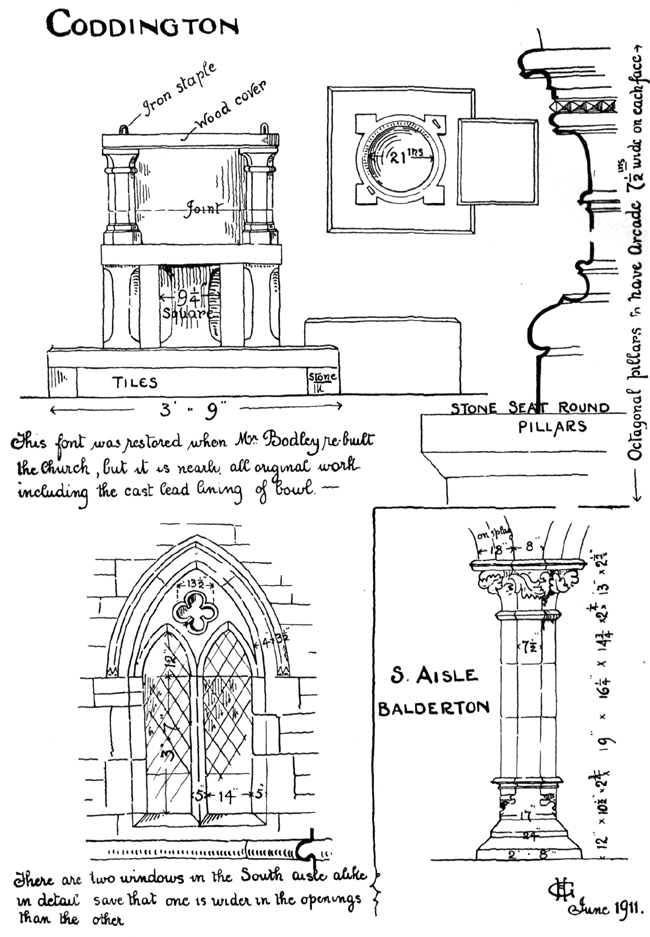Summer Excursion.
ON Thursday, the 15th of June, one of the finest days of a splendid summer, about fifty members assembled at Newark for an excursion to four of the neighbouring villages. Those who arrived early, inspected the castle, its dungeons, and the chamber in which King John is said to have died. After the morning visits the party returned for lunch to the Newark Town Hall, the use of which had been kindly granted by the Mayor, Dr. Appleby. There was a short inspection of Newark Church, prior to the afternoon work.
The following papers were read at the respective churches.
CODDINGTON CHURCH.
By the Rev. Atwell M. Y. Baylay.
I wish we could see Coddington Church to-day as it was before the "restorers" took it in hand. It would be difficult to find a more glaring instance of a church being travestied under the name of "restoration." And the pity of it is, that it should have been done by Mr. Bodley, whose name is associated with so much that is excellent. But here, of course, we have a piece of his early work, when he was still under the baleful influence of Sir Gilbert Scott and his school. It was in 1864 that he restored Coddington Church, and I cannot but feel sure that in his later years he would have dealt with it on altogether different lines.
Previous to restoration, the church had a clerestory, and, I am told, a beautiful clerestory: and both side-aisles had lean-to roofs. Having destroyed the clerestory, Mr. Bodley not only placed a high-pitched roof on the nave, but another on the south aisle, finishing the roof flush with the gables without any tabling, as if he were in Sussex, instead of in a county where good building stone is abundant. The result is architectural discord.

However, to come to the history of the church. In the 13th century there was here already a church with a tower, nave with two side aisles, and no doubt, a chancel, probably of small size. Of this date we have the western lancet window, the font, the two arcades, the north and south doorways, and some lancet windows in the north side of the church. I am inclined to think that the south aisle was widened not long after, in order to give better accommodation for a chantry chapel, as its beautiful east window, and the window heads in the south side, seem to be a little later than the arcade. But in this I may be mistaken, and the whole south aisle may be somewhat later than the north. This aisle was completely re-erected in 1864, but on the old foundations. Both arcades have the expanded bases which provided a substitute for seats in the nave, and there is also a curious stone bench at the west end of the south aisle. The arcades, as usual differ in character, but this is no sure indication of any difference in date. The "nail-head" ornament in the capitals of the north arcade is merely one instance, out of a great many, of how the Nottinghamshire masons clung to this ornament throughout the 13th century. The rough masonry of the tower was cased with ashlar outside in 1864, and the present tower arch is of this date, as is also the chancel arch.
Not much seems to have been done to the church in the 14th century. The west windows of the two side aisles are the only features that attract notice.
To the late 15th century belong the belfry windows of of the tower, and its parapet and pinnacles. There are also two pairs of ancient bench-ends preserved in the north aisle.
I am sorry I can tell you nothing about the ancient chancel. It has been entirely removed, and replaced by a new one of Mr. Bodley's. The new work has not stood well, and has had to be substantially buttressed in recent years to prevent its falling.
Some ancient sepulchral crosses, mostly from stone coffin lids, but one possibly from an upright grave-stone, have been built into the interior walls of the vestry.
The oldest register book has been lost. Those existing only go back to the time of Charles II.
There was in this church a richly endowed chantry, founded by Henry of Coddington, the altar of which was probably in the south aisle.
The dedication of the church is given as "All Saints."
